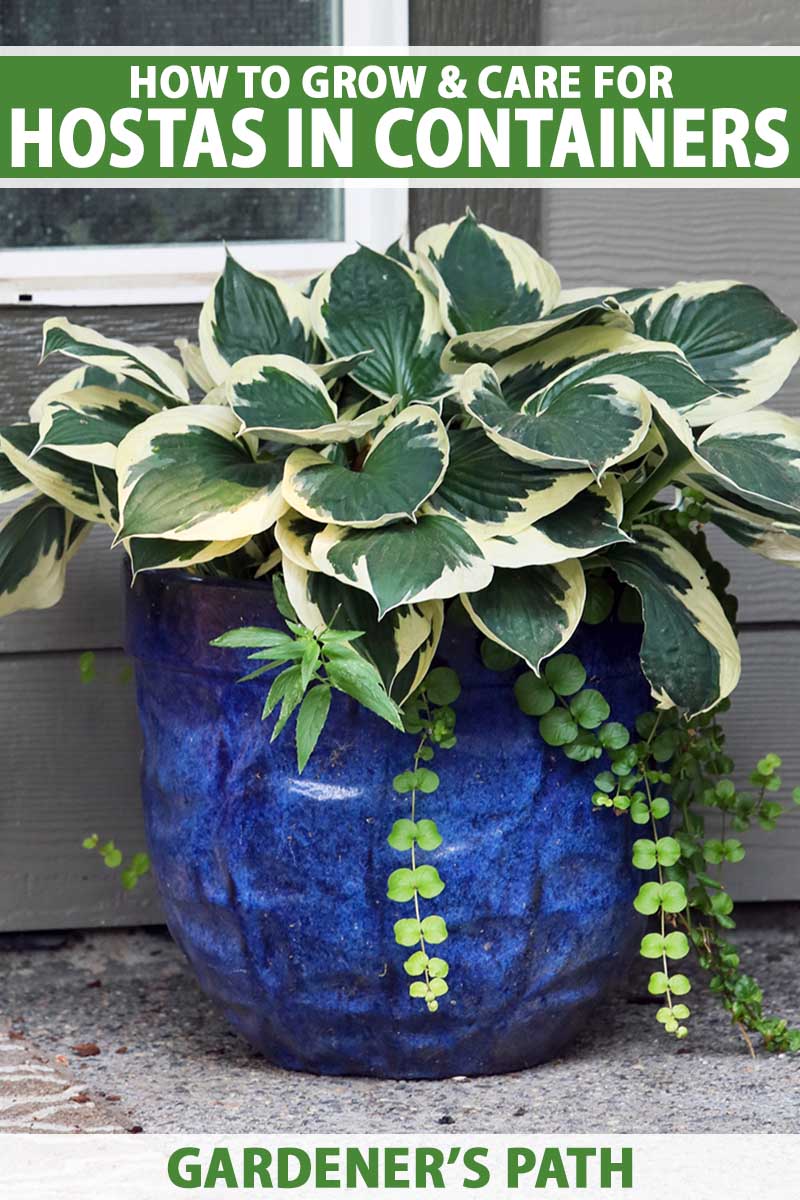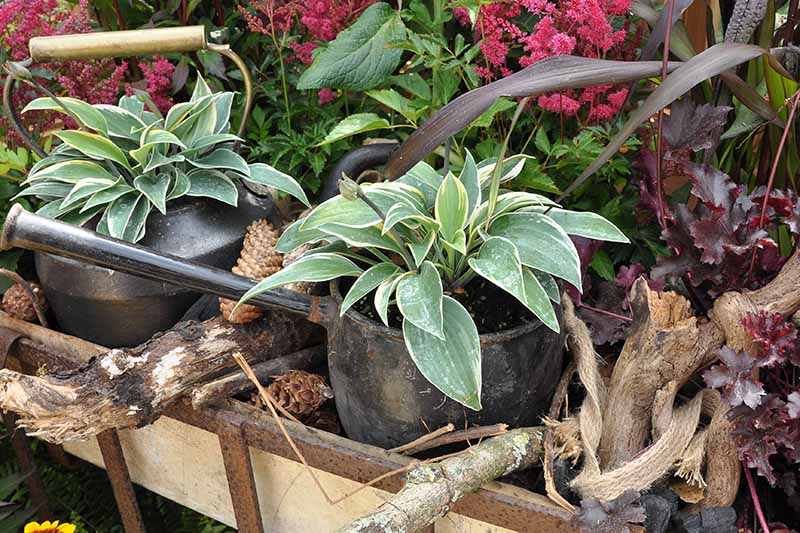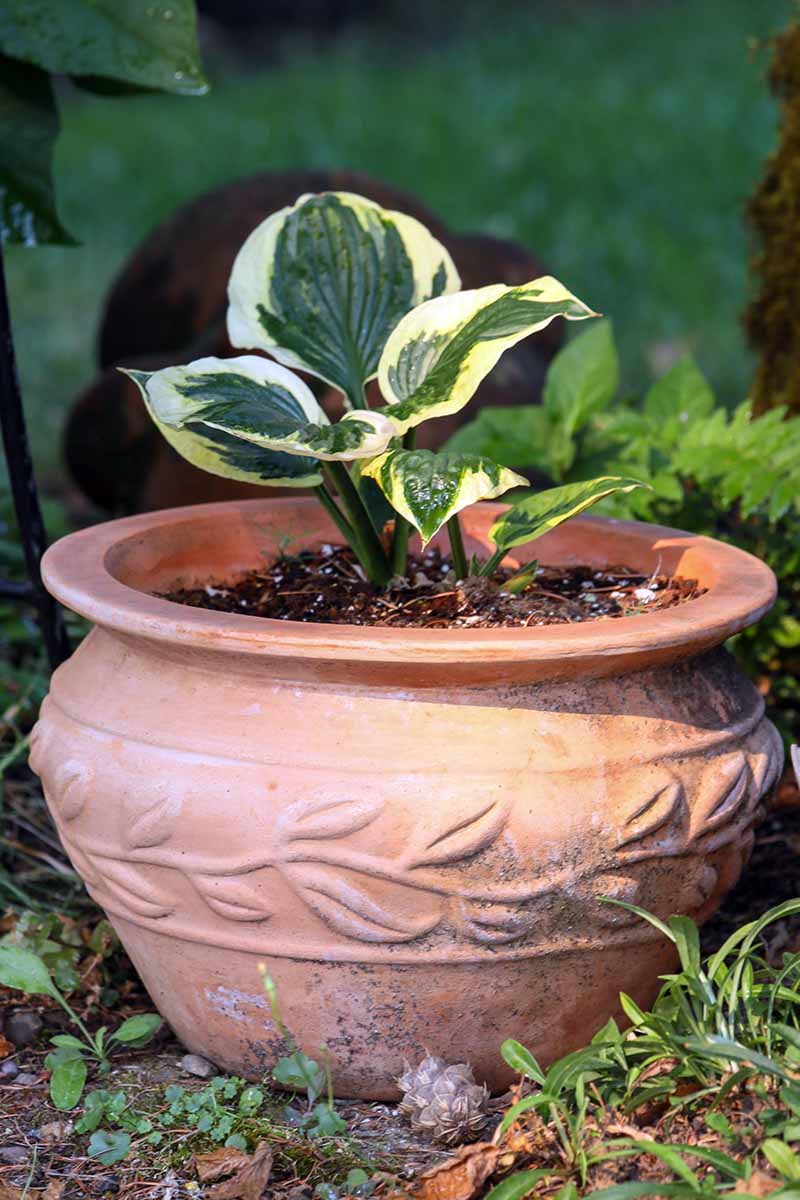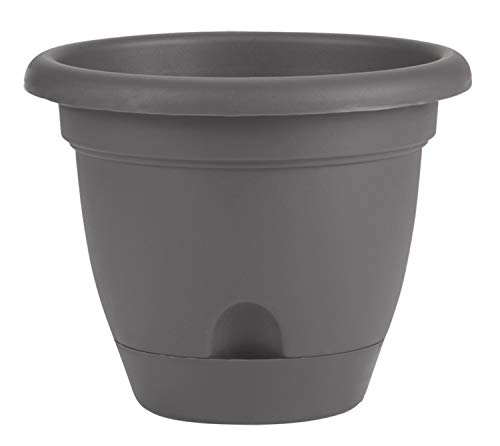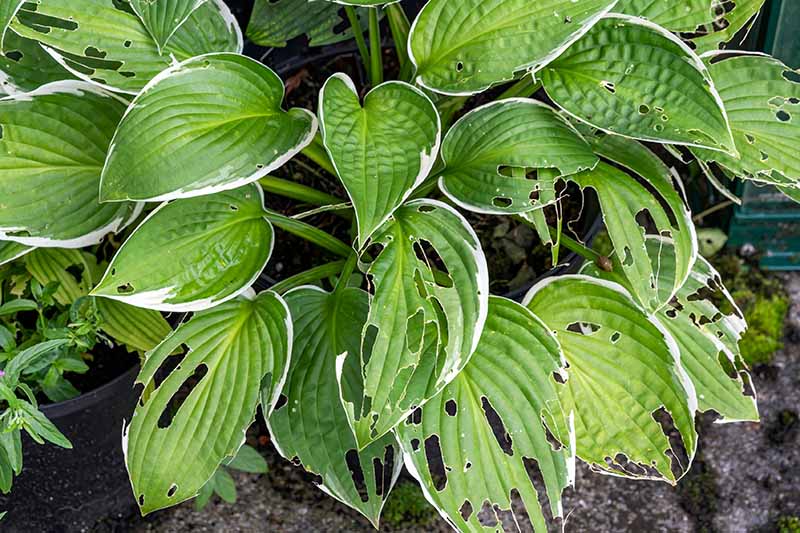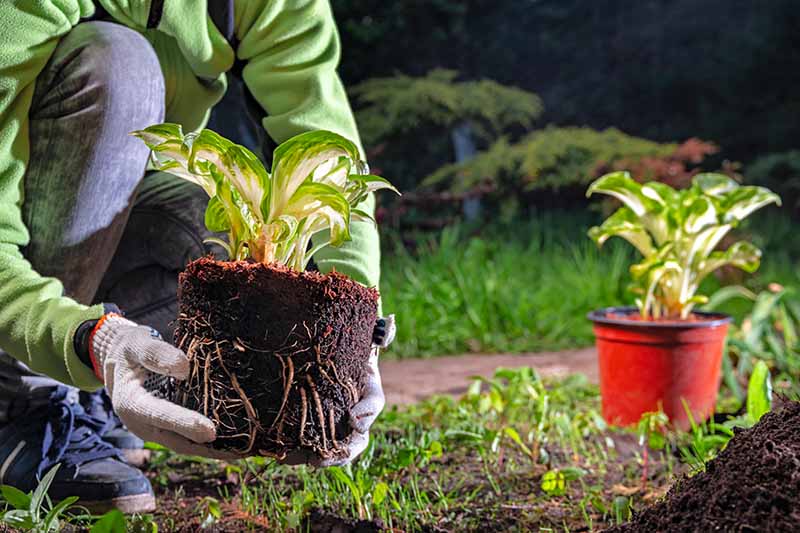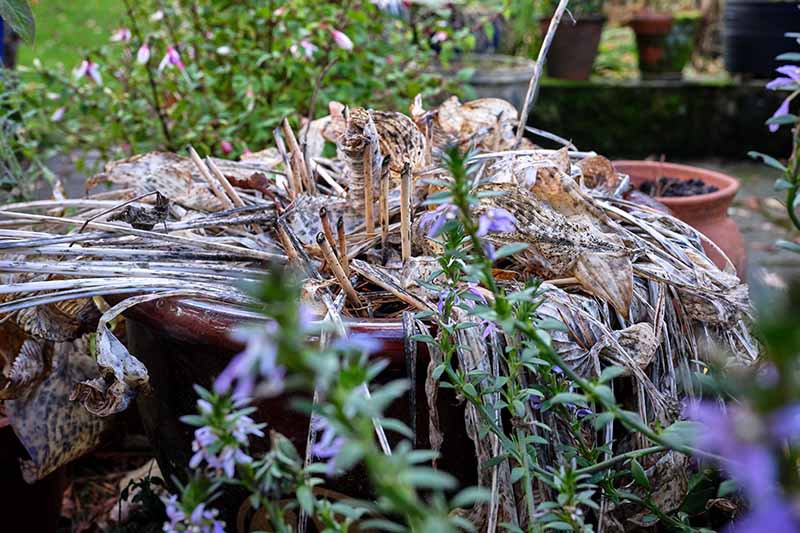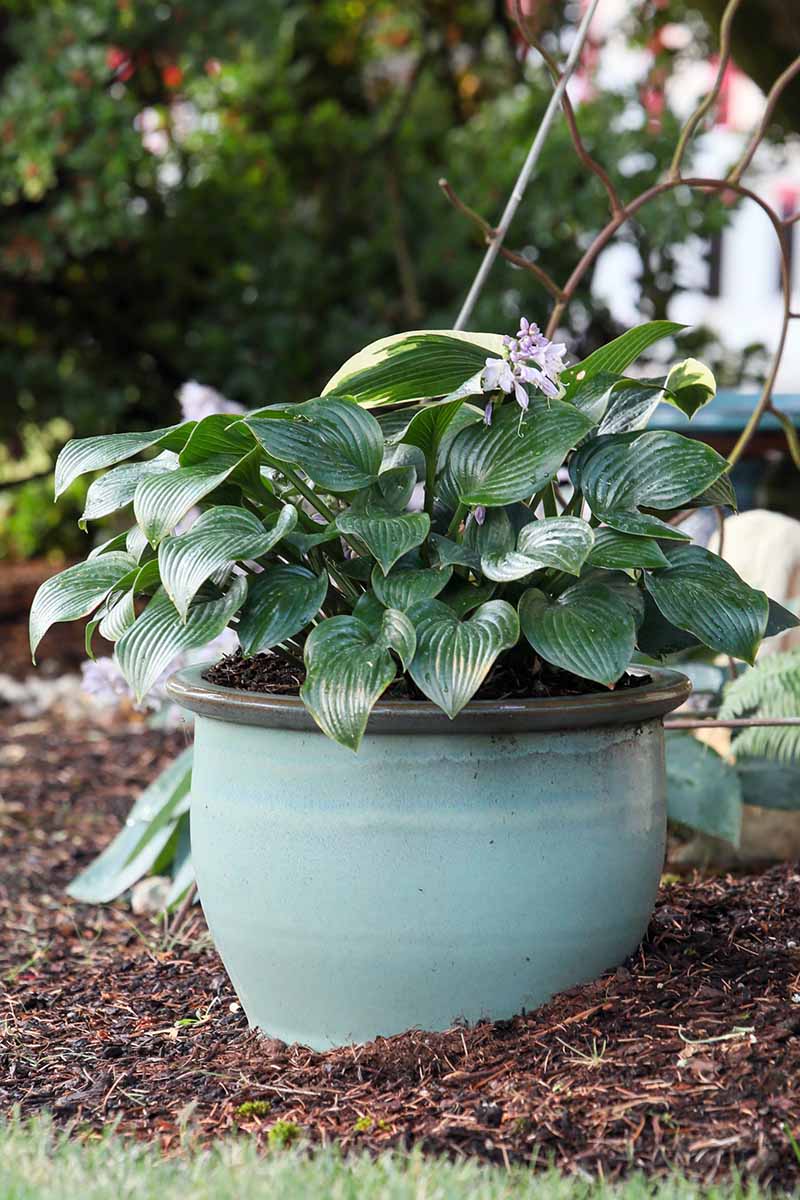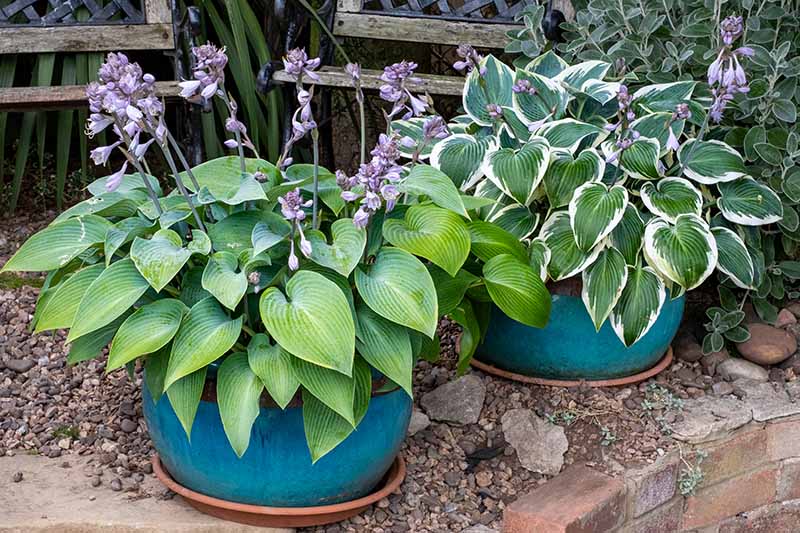While they’re perfectly gorgeous growing in the ground, there’s no reason they have to stay there. These popular plants can make a big statement when you put them in containers, whether alone or with other companions. Instead of serving as accents in the garden beds, they can be the crowning glory of your patio or garden space. Or you can create a welcoming display in a shady spot on your porch where other plants fail to thrive. We link to vendors to help you find relevant products. If you buy from one of our links, we may earn a commission. Some people grow plantain lilies – as they’re sometimes called – in containers, but keep them in the garden so they can have some extra height. And, of course, growing them in pots lets you bring the beauty onto your patio or deck. In our guide to growing hostas, we cover the basics. Whatever your motivation for container growing, in this article we’ll help you pick the right pot and learn how to keep your hosta healthy. Here’s what you can expect, coming up: If you love these leafy garden staples, all you need is a tiny spot, a good pot, and some gardening know-how. Let’s dive in.
Choose a Good Container
Hostas come in a wide variety of sizes, so I suggest selecting your plant first and then deciding on a container. That is, of course, unless you have a particularly pretty pot already that you’d like to use. With thousands of species, hybrids, and cultivars available, you’re sure to find one that will fit the bill. Before we jump in, just be aware that hostas generally grow to a smaller size in a container than they would the ground, which can be a good or a bad thing, depending on your goals. So if you pick a cultivar that grows four feet tall, while it’s possible for it to reach its full size, it’s more likely that it will be a bit smaller. Plan accordingly. What does the ideal container look like? You can get away with using quite a range of options, but in the perfect scenario, here’s what you should look for and keep in mind. Plantain lilies have roots that are wider than they are long. At a minimum, the roots will grow horizontally as far as the foliage does, but not as deep as the foliage grows. Choose a pot that is wider than it is deep, or with at least the same depth and width. You can use a pot that is taller than it is wide, but you’ll need to transplant or divide more frequently since the roots won’t fill the lower portion. An alternative is to buy a container that is taller than it is wide and place an empty liter-size bottle in the bottom of the pot. Make sure the bottle isn’t crushed and the cap is in place so it holds its shape. This will take up some of the extra space and reduces the weight of the container. Use a pot that is the right size for your plant right now, not the size it will ultimately reach. You want a pot that provides about three inches between the base of the plant and the side of the container. Hostas prefer for their roots to be cool, so don’t pick a black or metal container. You might also want to avoid clay on concrete because this material can crack and split in the winter, though you can find glazed types that are guaranteed not to crack for up to a decade. Consider using recycled plastic or fiberglass pots, which are better for the environment than plastic containers. You can also use pressure-treated wood. Whatever material you choose, make sure the pot has drainage holes. They don’t do well in standing water.
Use the Right Soil
One of the best things about growing in containers is that you don’t have to worry about perfecting the soil like you do when growing in the ground. You can simply buy the perfect soil to start with. Hostas prefer loamy earth and do best with a well-draining, water-retentive, rich medium. Any standard potting soil will do, so don’t stress about it too much.
How to Grow
Plantain lilies like a good amount of moisture. That’s part of the reason they do so well in some shade. Rice Hulls I prefer rice hulls because they are better for the environment, and more affordable. You can pick some rice hulls up at Arbico Organics in quarter-, half-, and one-cubic-foot bags. The moisture sticks around longer in places that aren’t exposed to the drying effects of full sun. But that presents a challenge for potted plants because pots dry out more quickly than the ground. You’ll need to provide extra water if you don’t live somewhere that receives regular moisture in the form of precipitation. Pots will need a little extra water during the warm summer months even in notoriously wet places like the Pacific Northwest. Those growing in the ground might be fine, but containers dry out fast. Make sure you’re watering at the soil level and not on the foliage. You might want to invest in a container watering system that uses drip irrigation to make things easier, particularly if you live in an area that is hot and dry. Once you’ve put your plant in place, add a layer of natural mulch like straw, coffee hulls, or pea gravel to the top to help retain moisture. Bloem Self-Watering Container Both of these options water at the soil level and keep your soil regularly moist. Now it’s time to put one rumor to rest. I’ve heard the suggestion that you should grow hostas in containers if you struggle with snails and slugs. I’ll just tell you now that it doesn’t help much. The slugs will climb up the pots and go to town on your plants. The one benefit is that those hungry gastropods will typically attack in-ground plants before they make their way up the side of your container, so you might get fewer snails than you would otherwise. Still, you might want to use some snail deterring tactics. One thing that’s certain about pots and pests is that containers will absolutely protect your plants from voles. If voles are your main pest problem, containers are the way to go.
Maintain Your Plants
At some point, unless you are growing a miniature hosta that stays petite, you will need to divide and/or repot your plants. Even with miniature hostas, you’ll need to replenish the soil every few years. To repot, select a container that is one size larger than what you are currently using, or use two pots of the same size if you’re dividing your hosta. Remove the plant from the existing pot. I think the easiest way to do this is to tilt the container on its side and roll it back and forth a few times, then grip around the base and gently wiggle it out. Knock away as much of the soil as you can, and trim away any dead roots. To divide, use a pair of trimmers or heavy-duty scissors to cut down the middle of the root ball and through the crown. Read our guide to dividing hostas for detailed instructions. Repot in new containers with fresh soil. If you see roots coming out of the drainage hole or circling the top of the soil, it’s time to repot. Once the base of the plant (not the leaves) reaches the side of the container, upgrade to the next size pot (or divide). The soil in containers tends to lose nutrients over time as the plant takes them up or when they wash out during watering. That’s why you need to fertilize potted plants more frequently than those in the ground. Use a balanced fertilizer designed for use on container plants. You can choose either slow-release or standard fertilizer. When it comes to winter care, you don’t want to bring your plants indoors into your heated home. Plantain lilies need a dormancy period below 40°F for at least a month. Proven Winners Premium Water Soluble Plant Food Remove the leaves in the fall, after they have died back and are completely yellow. If you want to provide winter protection, your best option is to move the pots to a sheltered spot like a garage or a shed. You’ll need to provide water, though not too much. Dormant plants only need a fraction of the water that actively growing plants do. Water once the soil dries out completely. How can you tell? Try lifting the pot – it will feel significantly lighter than normal. You can also cover the container in pine boughs and leave them in the garden. The pot under the boughs should receive enough snow or rain to keep the hostas happy if they are placed somewhere without too much cover. However, if your hosta is hardy to at least one growing zone below the one you are in, you don’t need to provide protection. So, for example, if you live in Zone 6 and your plant is hardy to Zone 5, you don’t need to do anything extra in the winter once the plant is established. Young plants should be protected in the first year or two. Container hostas often start emerging earlier than in-ground hostas, so keep an eye on your plants and bring them outdoors or remove any coverings once the shoots start to emerge.
Best Uses
Container plants are the perfect thing if you want to bring color and texture to your patio or porch. Hostas in particular make a lovely statement flanking the entrance to your home, especially if you have an awning, large tree, or a cover over your doorway providing shade. Groupings of potted hostas make an interesting focal point. A variegated type paired with one that has yellow foliage or one with blue leaves stands out. Bonus points if they have impressive blossoms. And really, don’t forget the flowers. While the greenery is hard to beat, some hostas have large, heavily scented blooms. Place these varieties near a seating area so you can enjoy the feast for the senses that they provide. Let’s step away from the patio for a minute now. Sure, a container lets you bring a hosta onto your porch or patio, but it can serve another purpose as well. I love to use them as a centerpiece or backdrop in a shady area, but they aren’t always tall enough to stand out among the other plants. If you want to add some height, put them in a container, place the container in your chosen spot, and voila! You can have the height and interest that you desire. People love to use hostas in shady areas, but these are often filled with a ton of tree roots. You don’t want to plant your hosta right in the middle of these. If you really want to place a hosta under a tree, put it in a container, and place the container on the ground under the trees instead of planting in the ground. If you choose small enough plants and containers, you can also move your hostas around with the changing seasons.
Cultivars to Select
Any type of hosta can be grown in a container. However, as I mentioned above, larger plants won’t ever reach their fullest potential size. If you pick a very large variety, you might eventually want to put it in the garden rather than fighting to keep it happy in a container. If you plan on growing your plantain lily with other plants in the same container, opt for one of the mini or smaller types. ‘Dragon Tails’ has thin, bright green leaves with wavy margins and stays under a foot tall. ‘Blue Mouse Ears’ is an incredibly popular plant, with small blue-green leaves that do, in fact, look like mouse ears. This adorable plant rarely grows over eight inches tall. ‘Coconut Custard’ grows to nine inches tall, and has striking pale yellow leaves with a purple stem. It has striking white leaves that gradually transition to light green as they mature. That means it provides colorful contrast all season long. ‘Hudson Bay’ Grab a ‘Hudson Bay’ of your own at Nature Hills Nursery in a #1 size container. ‘White Feather’ can reach three feet tall in the ground, but in a container, it stays around 18 inches tall. ‘Loyalist’ tends to top out around 18 inches tall and has large, dark green leaves with contrasting creamy variegation down the middle. Mini hostas are fun to play with. They stay so small that you can put them in unusual containers such as pitchers, old wood tool boxes, a toy wagon, birdhouses, or even a mug. Just be sure to put drainage holes in. They’re also ideal for rock gardens. Just be aware that they don’t do well in heavy clay soil. You also need to be extra diligent about maintaining the appropriate moisture in a rock garden, particularly if the soil is sandy. Mini options include ‘Itsy Bitsy Spider,’ ‘Little Treasure,’ ‘Mini Mouse,’ ‘Carolyn’s Gold,’ ‘Blonde Elf,’ ‘Little Wonder,’ ‘Crumb Cake,’ and ‘Rock Princess.’ Once you have your plant potted up, come back and let us know which hybrid or cultivar you chose and how you ended up using it. We also have some more hosta guides that you’ll hopefully find useful:
19 Favorite Hosta VarietiesKeep or Cut: How to Make the Most of Hosta FlowersWhy Are My Hosta Leaves Turning Yellow? 9 Causes and SolutionsHow to Identify and Manage 7 Common Hosta Diseases
